
2. Pest
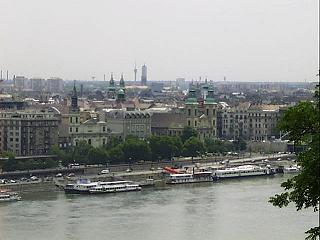
Pest, on the opposite bank to Buda, is now united to its neighbour by several bridges. This is in effect the city centre, with the main shops and buildings. The main thoroughfare is the pleasant Váci útca parallel with the Danube which is pedestrianised for its entire length but split in two by the new road (pedestrian underpass) coming off the Elisabeth Bridge from Buda first built at the end of the C19. This road passes within a couple of metres of the oldest building, the Inner City Parish church (above centre right), which was threatened with demolition in the first plans. I will start my tour at the southern end of the Váci útca, and will guide you in the order I visited these churches. Depending on how long you linger at each church (or café!), this route could take the best part of a day. I started at 1030 and finished at 1600, and welcomed a return to the architecturally-wierd Hotel Gellért and its thermal pools and Turkish Baths to relax!
The Váci útca starts opposite the huge Central Market halls close to the Szabadszag hid (Freedom Bridge) which links Gellért Hill to Pest. After a short distance Szerb útca leads off on the right.
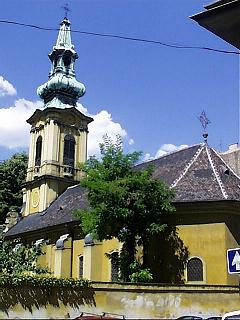
Serb Street leads to the small walled enclosure of the Serbian Orthodox Church (Szerb Templombelső), dedicated to St George. A Serbian church stood here even during Turkish times but was damaged in the battles of 1686. Rebuilding began in 1695-8, the wooden tower was replaced in 1731 and a new nave followed in 1733 but was not completed until 1752. The churchyard is peaceful, with trees making photography difficult! The interior (small admission charge) is time-warped. Small, with stalls around the walls of the nave and a small bank of seating at the rear under a little gallery, the whole east wall of the nave filed with the iconastasis beyond which is the small apsidal chancel. I did not stop to count the number of icons on display. Photography inside was not permitted.
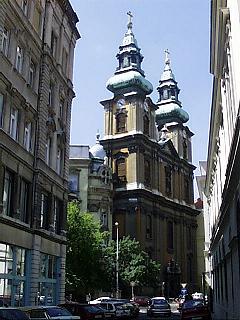
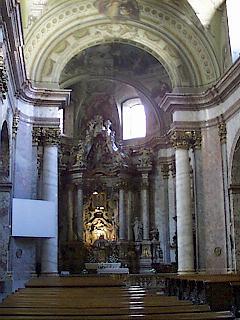
Continuing to the end of Szerb útca, turn left and on the left is the University church (Egyetemi templom). Twin towers flank the principal entrance. The interior is stately and with some excellent fittings, but a little shabby and dark. AND one of my pet hates is clearly visible in the interior picture, seemingly becoming a necessary part of modern worship - the overhead projector screen. These are particularly disharmonious when left open, a solid rectangular blank amid the C18 ensemble. Built for the Paulite Order 1725-42. Oh and don't check your watch by the tower clocks, each face showed a different time when I was there!
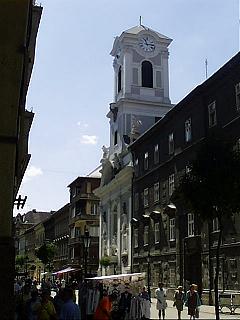
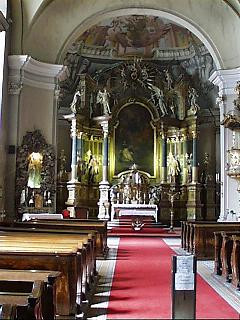
If you turn left outside the church this road brings you back to the Váci útca and the small church of St Michael (Szent Mihály templom). Built 1747-9 on the site of a medieval Dominican church, it has a rich main altar of 1760. The church was also the conventual church of the Order of English Girls.
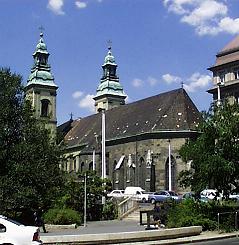
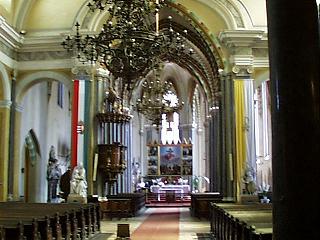
Suddenly the Váci útca has some traffic and the Elisabeth Bridge (Erzsébet híd) hoves into view along with the Inner City Parish Church (Belvárosi Plébániatemplom). The approach roads to the bridge pass within a few metres of the church, the oldest foundation in Pest. Its origins are in a Romanesque two-towered basilica, traces of which can be seen built into the south wall of the nave. Today it is a church of two halves, a baroque western half, built on the ruins of the Gothic Hall church's nave and aisles, and the surviving Gothic east half, now an amalgam of original C15 and neo-Gothic forms. This eastern part was used as a Mosque, and a muslim prayer recess can still be seen in the ambulatory. The interior too is an uncomfortable juxta-position of styles.
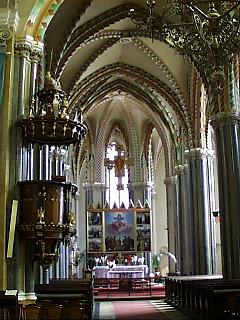
Viewed on its own the medieval hall church eastern half is more satisfying, yet many features were only revealed in the major restoration of 1932-44. Immeditely work then began on repairing war damage. The fittings are by and large relatively new.
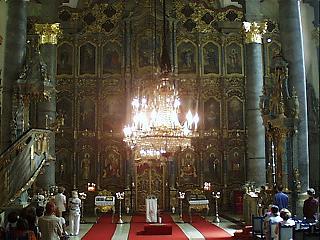
Following the pedestrian walkway along the Danube brings you to Petőfi tér where the Greek Orthodox church (Gőrőgkeleti templom) is situated. This formerly presented a twin-towered facade (of 1872-4) to the river, but the SW tower was destroyed in 1944 and has not been rebuilt (see title picture above, church centre left). The church behind the facade is older, 1791-4 and has a spacious nave and aisles with slim Corinthian columns supporting the roof. There is a huge iconostasis and shortly after this picture was taken the two central doors opened to reveal several priests richly dressed in golden robes and a richly appointed altar. It felt like a piece of theatre as we watched from the west vestibule.
The road at the side of the church leads back to the Váci útca. A modernistic walkway through glazed office frontages to the right would take you to the Servite church and the Lutheran church, but I found neither open. Best to have a rest and a drink in one of the cafes as our pedestrian road opens out into a pleasant square (Vőrősmarty tér) and terminates. The many streets to the north and east will take you towards Budapest's Cathedral of St Stephen, otherwise called The Basilica.
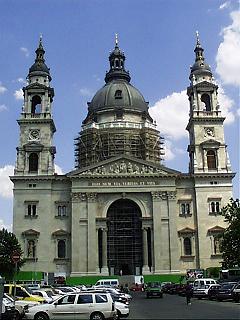
The church was begun in 1851 to the plans of József Hild, who died in 1867. Another architect Miklós Ybl took over and detected flaws in the nearly completed structure. In January 1868, eight days after he withdrew all the workmen and fenced the site off, the huge dome collapsed. The church had to be begun anew. Ybl too never lived to see the church completed, dying in 1891. The church was consecrated in1905. Badly damaged in World War Two, and the dome burnt out by fire in 1946. Since 1989 there has been a major restoration of this huge church ongoing. The facade looks wonderful now it is cleaned and is in stark contrast to the rather blackened stone of the side walls and apse. Unfortunately tourists arrive by the coachload.
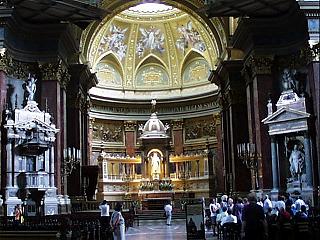
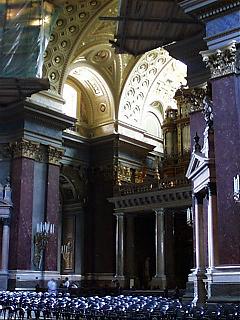
In plan it is really a greek cross with E apse, a dome and flanking towers to the west end. The dome was sadly still full of scaffolding but the main body of the church is fully restored and redecorated. This is in sharp contrast to the one bay side chapels east and west of the transepts where years of neglect and grime show the state of the interior during the communist era. The church was made a co-cathedral of the archdiocese of Esztergom-Budapest in 1993. (I recommend the small restaurant south of the SW tower on the street corner too by the way!) Along with the traffic, trams etc follow the Károly kőrút until the towers below come into view.
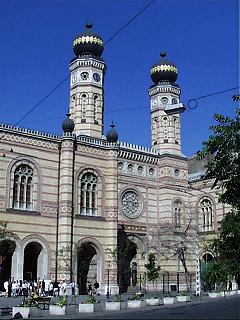
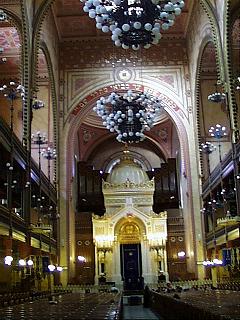
In a major departure for this site the building above is NOT a church. This is the Great Synagogue in the Dóhany utca. It is the second largest synagogue in the world (Largest is in New York). Built 1854-9 to the plans of Ludwig Forster, it is built of brick and iron, more like a cathedral to look out and in a sort of Byzantine-Muslim style. The arcades are of cast-iron (I know, I knocked them). The pews are still inscribed with the names of the families who occupied them, many of them dying out in the Pest Ghetto in WW2. Recently restored to all its glory, the interior is breathtaking. Two tiers of galleries for the women, and some astonishing light fittings too! This was well worth the admission charge which also includes entrance to the Jewish Museum next door with its richly appointed exhibits. Back to the Károly kőrút to the major crossroads and turn right heading back to the Elisabeth Bridge, and on the left our final church is seen.
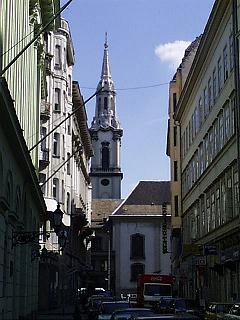
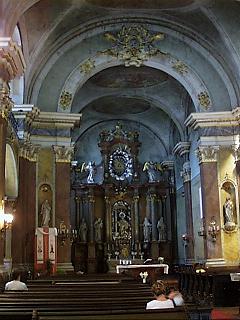
The Franciscan Church (Ferenciek templom) is a medieval site, their church was turned into a mosque, and back into a church again in 1686. However the entire church was rebuilt 1727-43. the tower, standing at the SE corner of the church looks more like one of Wren's City of London steeples, and in fact the top dates from 1861.
From here I went back to the Hotel, and had a wonderful ice-cream on the way from the small gellateria I passed earlier between the University and St Michael's churches for 60ft (15p, 20c).
Back to the Hungary Pages Intro and Index